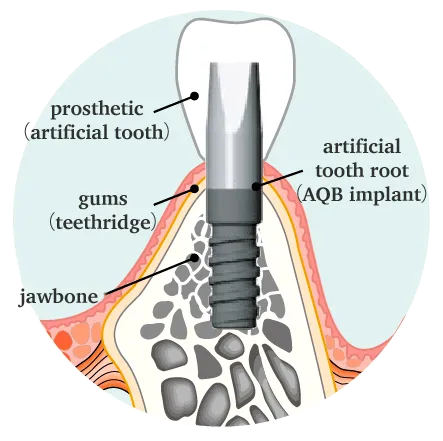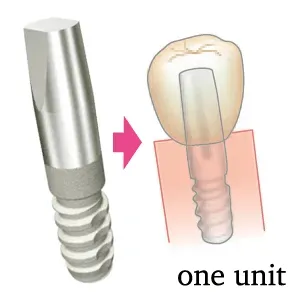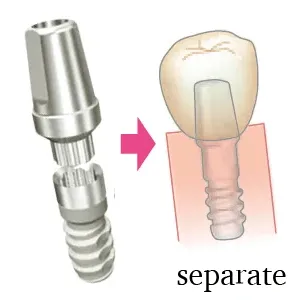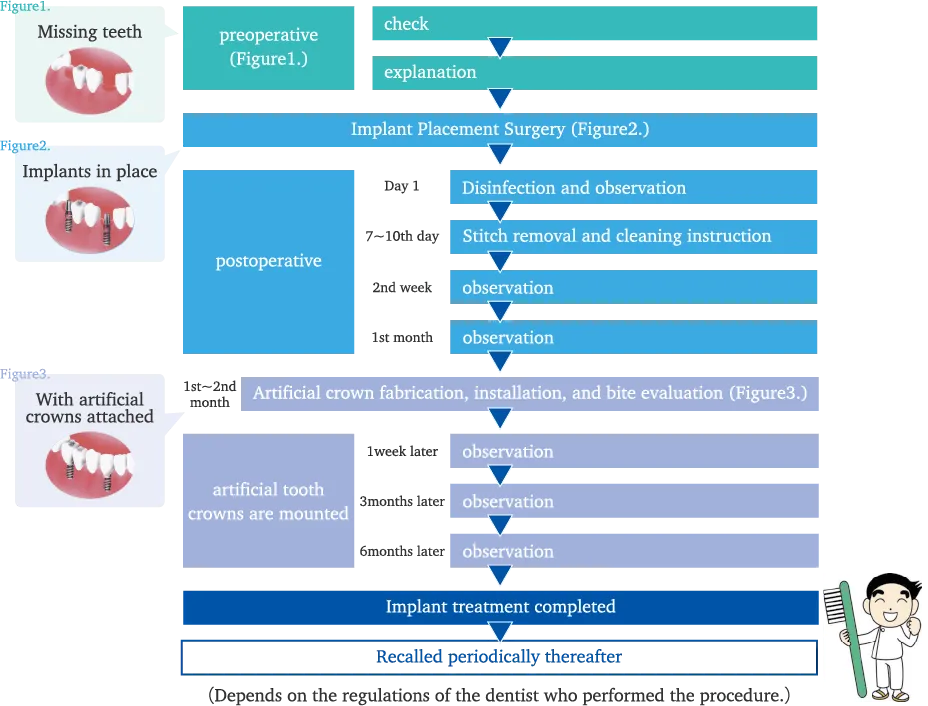What is Implant Treatment?
What is Implant Treatment?
In implant treatment, an artificial tooth root is surgically implanted in the area of a missing tooth, and after it is fixed to the jaw bone, an artificial crown is attached to the top of the tooth.
Implants are not permanent, but with continued daily cleaning (tooth brushing) and regular checkups, a good long-term prognosis can be expected.

History of Implants
Its origins can be traced to ancient Egyptian civilization. The oldest implants that are thought to have actually functioned are those of the Mayans around the 7th century using shells. Implants that are considered new actually have a long history.
The foundation of modern dental implants began about 100 years ago with screw implants placed in missing tooth holes by Western dentists.
Titanium is currently the predominant material for implants.
Titanium was discovered to bond to bone by Swedish Professor Brånemark in 1952, and further research has since proven the reliability of osseointegrated implants made of titanium based on scientific evidence, which has led to a major breakthrough in implant treatment.
The human body has a tendency to recognize titanium as an ally.

Two types of implants
| 1 piece | 2 piece | |
|---|---|---|
| form |  |  |
| forte | The “implant body,” which is an artificial tooth root placed in the jaw bone, and the “abutment,” which connects the artificial tooth, are integrated. | This type connects the “implant body,” which is an artificial tooth root that is inserted into the jawbone, and the “abutment,” which connects the implant body to the artificial tooth, with a screw. |
| Number of surgeries | once | At least twice in principle |
| surgical procedure | trees planted to grow in the ground | Placement + Incision |
| Operation Time | 30 to 60 minutes (per session) | 60-120 minutes (2 sessions) |
| Length of treatment | Approx. 1 to 2 months | Approx. 2 to 6 months |
| Length of time to be able to eat | Approx. 1 to 2 months | Approx. 2 to 6 months |
Why Implants Are Awesome
- Merit
-
- Feels super close to your real teeth
- No loss of bite strength or taste
- Doesn’t mess with other healthy teeth
- Looks good too!
- Demerit
-
- You’ll need minor surgery (like getting a tooth pulled)
- Not for everyone
- ・If you’ve got serious health issues
- ・If your jawbone’s too thin or weak
Basic Steps of Implant Treatment
Implant treatment follows the steps below. (Duration may vary depending on the case.)

Precautions for Implant Treatment
Before the Implant Surgery
- ① If you’re feeling unwell due to a cold or similar, don’t decide on your own—please contact the dental clinic early.
- ② The day before surgery, get plenty of rest and avoid fatigue.
- ③ On the day of surgery, you can eat a regular breakfast.
1–10 Days After Surgery
- ① Rest & Diet
- To allow the implant to firmly bond with the jawbone, avoid putting pressure on the implant. For the first 3 days, try to eat soft foods like rice porridge and absolutely avoid chewing on the implanted side. Swelling may occur until days 3–4, but it usually subsides by days 4–5. If swelling is bothersome, use a wet towel to cool the area—avoid pressing it firmly.
- ② Medication
-
You’ll be prescribed painkillers, antibiotics, and stomach medication. Follow the dosage instructions. Leave at least 3 hours between painkiller doses.
You’ll also get mouthwash—use it after meals and before bed. Some blood in saliva is normal for 1–2 days. Don’t rinse too vigorously to keep the surgical site stable.
- ③ Bathing
- Avoid bathing on the day of the implant surgery. A quick shower is recommended instead.
- ④ Oral Care & Diet
-
Stitches will be removed in 7–10 days. Until then, do not brush the implanted area.
Continue avoiding strong chewing force on the implant site.
One Month After Implant Placement
The first month after implant surgery is the most crucial period. Continue eating soft foods and try not to chew on the implant side. Also avoid touching the implant with your tongue or fingers.
Once the wound heals, use a soft toothbrush for cleaning.
Placing the Prosthetic Tooth (Crown)
The crown is placed 1–2 months after implant placement, once it’s judged to have bonded with the bone. At that point, an impression is taken and the crown is attached.
If you grind or clench your teeth, a night guard is recommended.
Check-ups After Crown Placement
Aftercare is crucial for implant success. Be sure to attend all follow-up appointments. After the crown is placed, follow-up visits are scheduled for 1 week, 1 month, 3 months, and 6 months later. Regular check-ups will also be scheduled according to your clinic’s guidelines.
Cleaning (Plaque Control)
After the crown is placed, plaque can build up more easily around implants. That’s why good plaque control (brushing) is essential. Depending on your situation, we’ll guide you on using interdental brushes, dental floss, etc., in addition to regular brushing.
If Problems Occur During Implant Treatment
- ① On the Day of Implant Surgery
- Even with preoperative exams, there are cases where there isn’t enough bone at the implant site. In some cases, the surgery may be canceled. If that happens, we may perform a bone graft later and reschedule the implant surgery after consultation with the patient.
- ② Around Two Months After Surgery
- If the implant is still loose after two months, we may delay placing the artificial crown and monitor the situation. In some cases, another implant surgery may be necessary.
- ③ After Treatment Completion (Post-Crown Placement)
-
There are cases where the artificial crown attached to the implant comes off or breaks. If that happens, please visit the clinic immediately.
If a crown on a natural tooth falls off or a tooth becomes loose, please also come in right away. This may be due to a change in bite caused by losing another tooth, which can put excessive stress on the implant.